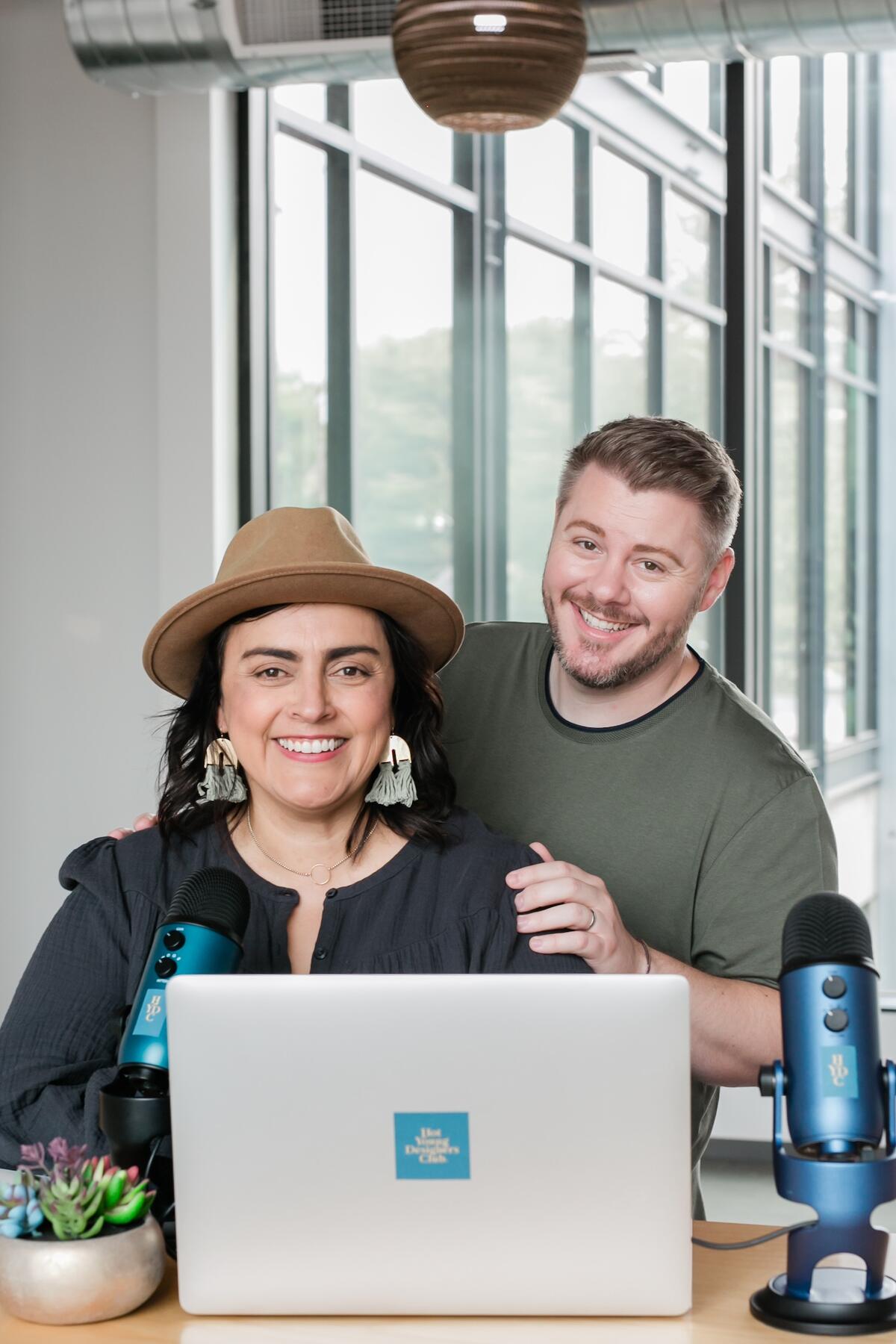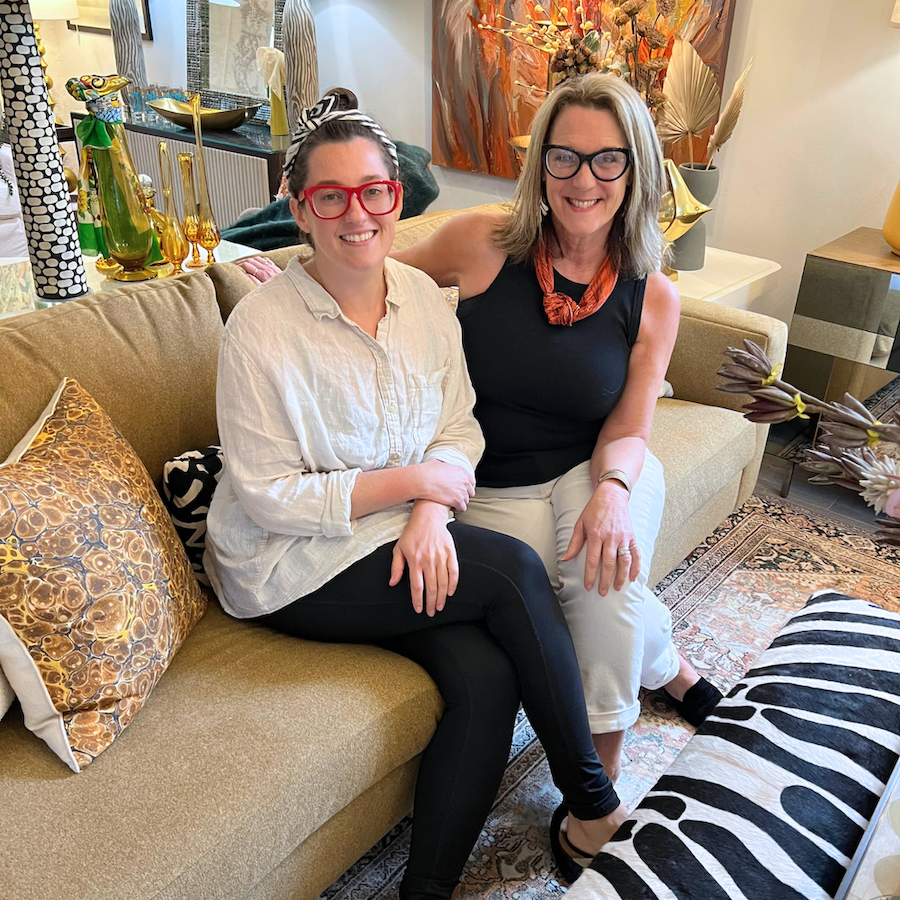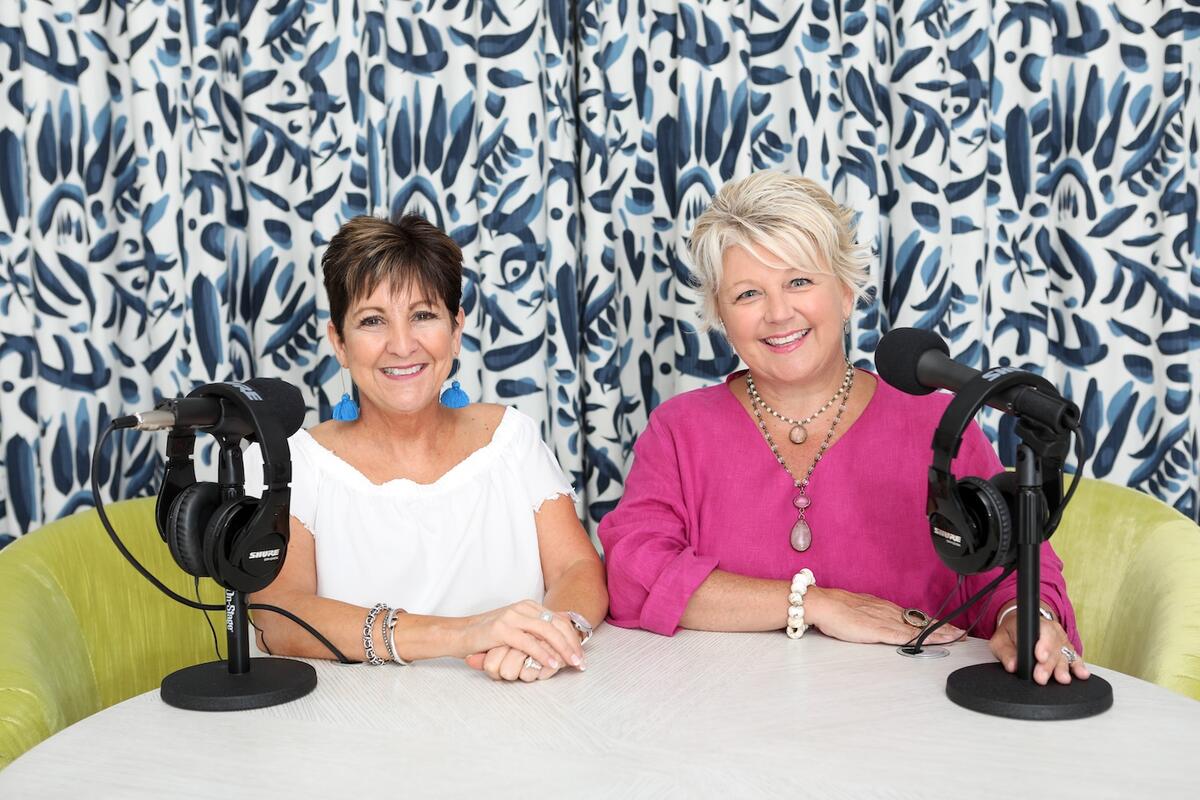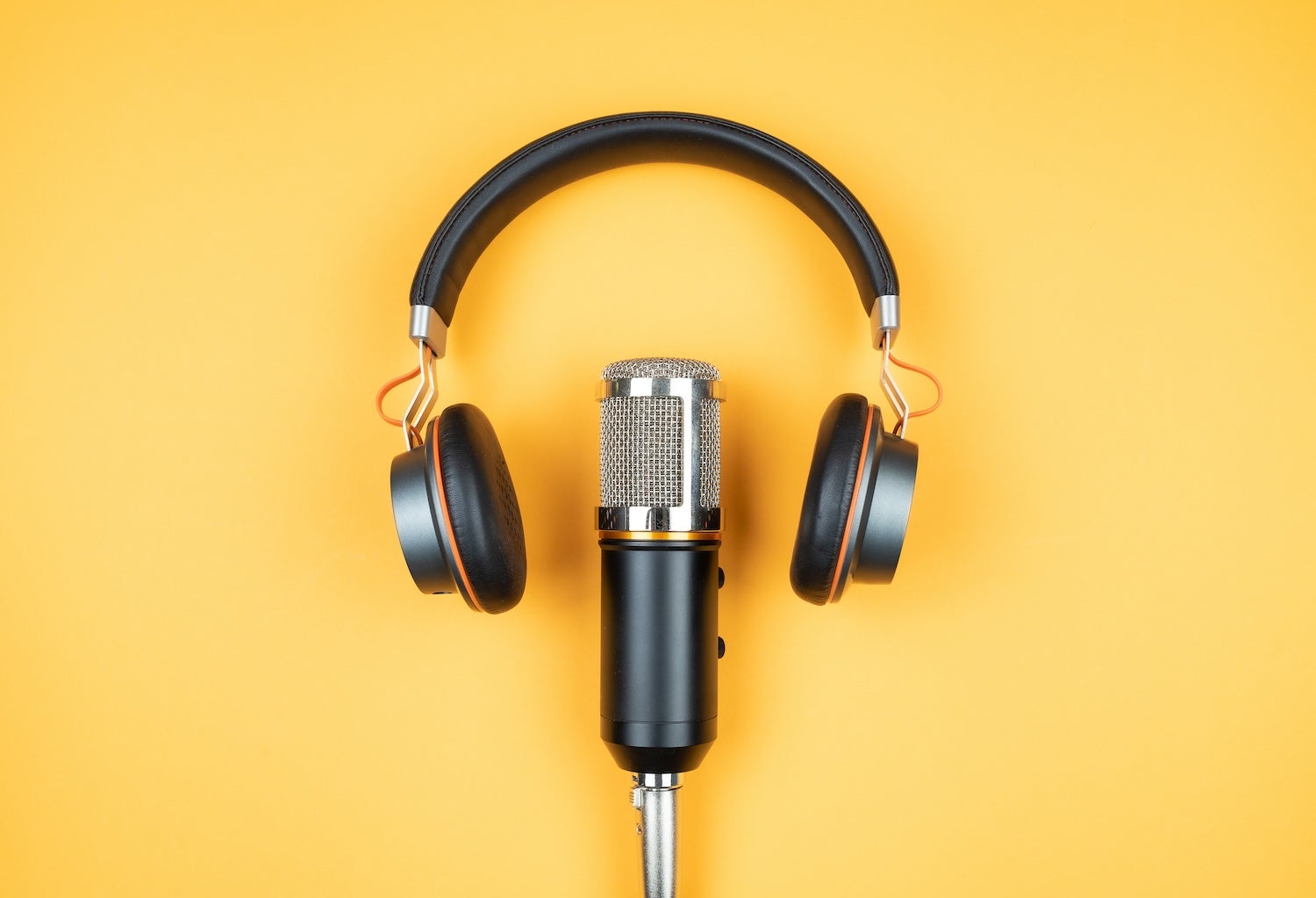When California designers Rebecca Plumb and Shaun Crha met at Las Vegas Market in 2019, they were attendees like anyone else. When they returned in 2021, post-lockdown, they were celebrities of a sort—this time, they were on the other side of the event, fielding questions as panelists. It was all thanks to the success of their podcast, the irreverently named Hot Young Designers Club.
In an industry that was historically slow to adapt to new technologies, the last few years have been a big leap forward. The Covid-era shutdowns in particular provided designers with the chance to explore new online worlds—and for many, that included podcasting. Today, the list of designers-turned-podcasters keeps climbing, including well-known figures like Athena Calderone and Jake Arnold.
That’s surprising for a profession that’s heavily centered around visual aesthetics. The medium isn’t the obvious choice as a tool for designers to share their work and build their audience—most who have explored the format haven’t found it to be a successful lead generator. And producing a podcast is no small feat, requiring designers to book and schedule guests, edit audio, publish finished episodes and advertise through marketing channels. But a wave of industry pros has found other uses for podcasting, namely, building a network, sharing business resources, and branching out into coaching and consulting.
The Podcast Boom—And Bust
For designers and friends Plumb and Crha, it was the first. The idea came about shortly after Plumb attended the Design Influencers Conference in March 2020, where she gleaned the importance of designers owning their own marketing channels instead of relying on the whims of constantly changing social media platforms. The pair would be stuck at home for the foreseeable future anyway—why not start a podcast?

“Shaun and I had [originally] met in January at Las Vegas Market that year, and we turned into high schoolers again. We were literally on the phone every day for at least an hour, and we finally had somebody to vent to, ask questions,” says Plumb. “We were like, ‘OK, we should be recording this and doing something with it, because it’s helping the two of us and no one else.’”
The pair launched the Hot Young Designers Club with the goal of helping others in the industry by sharing business-building resources, tips and personal experiences. “So much of the industry is behind this wall. … There’s still a lot of gatekeeping, a lot of looking down your nose at designers who haven’t gone to design school,” says Crha. “There are two schools of thought: Protect it and keep it all hidden and don’t talk to people who don’t know, or talk about all of it so designers can learn and get better and be vulnerable with each other.”
As the pandemic dragged on and demand for design services began to boom, the podcast consumed more of the duo’s time, energy and money. (Designers say producing each episode can cost hundreds of dollars depending on equipment, hosting software and outside support.) “At that point, the podcast was a nonprofit labor of love. We weren’t monetized, and we could spend three to five hours a week recording the show, pitching guests and doing all the production,” says Crha. “When your design business is the main driver of your income, it’s really hard to say, ‘Sure, let me take away that many billable hours when I’m already stressed and tired.’”
For the early months of 2021, the designers took a break from the podcast. The shift came when they returned to Vegas Market that year, where they had a chance to meet face to face with listeners. “We [realized that we] did the thing that was the hardest—we built a genuine connection with people in the world—and we can’t get over the logistics?” says Crha.
Their response was to find ways to monetize the podcast, starting by selling ads, with the goal of building a revenue stream that would allow the pair to hire a team of assistants and editors to take on production tasks, graphics and social media. They also launched a Patreon account, where listeners could pay to receive digital resources such as calculators and templates the two designers had implemented in their own businesses. “We had to kind of reverse engineer a business out of it,” says Plumb.
Plumb and Crha’s experience shows that while the launch may not demand a big investment upfront, transitioning a podcast into a long-term commitment may require designers to reframe the venture as a new arm of their business, one that requires its own resources—and generates the revenue to justify them.
Getting On the Air
Meanwhile, designers whose firms already have a coaching or consulting arm have entered the podcasting arena from the other end. As a designer and business coach, Pensacola, Florida–based Cheryl Kees Clendenon wanted to lean into the former role with her podcast, Damn Good Designer, co-hosted by Liz Lapan. Since coaching accounts for 25 percent of her business, it made sense to invest in the podcast as a marketing tool.

“I wanted people to hear my voice as a consultant,” says Clendenon. Part of the objective behind starting a podcast was to go beyond her existing online communities, like Facebook, where she operates a nearly 3,000-person group. “I felt like a podcast could go further and amplify that. … It’s a great marketing vehicle to get your name out there and get people to hear what you’re all about.”
Clendenon views podcasting as a marketing tool with more staying power than social media: An episode can’t get lost in a timeline-focused feed, for example, and podcasters ultimately own their work separate from the platforms they’re hosted on. Plus, the goal of reaching the maximum audience possible isn’t relevant when operating a podcast in tandem with a consulting business—converting just one listener into a client makes the venture worth it, she says.
“If you’re trying to launch [a podcast] that’s really popular, where you’re looking for the entire United States to be listening, well that’s a whole other ball of wax,” Clendenon adds. “When you’re talking about a more niche market, with consulting or even consumer-facing, I think it’s a completely different thing.”
But for some designers, building a new arm of their business to justify launching a podcast isn’t always worth it. Kelly Collier-Clark formed the basis of her podcast on another medium that was hot during the height of lockdown: Instagram Live. There, her real-time designer interviews were a fan favorite, which made transitioning the conversations to a podcast format an easy decision. The project benefited her Philadelphia-area firm as well, allowing her to learn how other designers worked and implementing their processes into her own.
As much success as Collier-Clark’s podcast enjoyed, it began to compete with her main design business for her attention, especially at a pivotal time when the industry was booming and her firm was beginning to find its legs. In the end, like Plumb and Crha, the designer decided to take a hiatus from the podcast in order to focus solely on growing her business—and her brand.
“You have to be careful with your brand and brand awareness—I’m keen on that. I didn’t like the idea of people knowing me as a podcaster over a designer,” says Collier-Clark. “I felt like, ‘That could cause a little confusion. Let me step back.’”
After all, the line between designer and podcaster can be a tricky one to toe, as many pull from their personal experiences to inform their content. According to Atlanta-based Joann Kandrac and Kelly Kole, hosts of the podcast Inside Design With Kandrac & Kole, that format requires its hosts to sign on for a certain level of transparency. With episodes like “How Not to Be a Nightmare Client,” the pair get candid about behaviors designers should be wary of, while maintaining the privacy of past clients.

“We talk about the challenges of our industry and our day-to-day challenges, but we tackle it from a very positive place,” says Kandrac. “It is more of a teaching moment—and if a client is listening, it would be very good insight for them to hear our perspective.”
Clendenon describes herself as “anti red-flag”—meaning, she doesn’t plan to take a client-critical position at any point on her own show. When discussing how her business functions, however, she’s not afraid to lay it all out there.
“I think people need to be less afraid of clients knowing that you make money,” she says. “We do have an episode about getting shopped—and we don’t get shopped, ever—so there might be somebody who says, ‘Oh, what’s that about?’ But I’m very upfront about it: This is how we operate, and we make it a win-win for clients.”
For Kandrac and Kole, their series began as a side hustle back in 2019; in the years since, they’ve taken on sponsorships and speaking engagements. In an industry that can be laborious—with long hours, demanding clients and high-pressure deadlines—they’ve enjoyed the freedom of podcasting so much that it has become a possible off-ramp should they ever decide to scale back their design offerings in favor of scaling up the podcast.
“We’ve been in business for 18 years, and we love design, but we’re ready to slow down a little,” says Kole. “I can’t ever retire, but I don’t want to be working as hard as we are right now. I always want to keep my toe dipped in and always be out there—but to a smaller degree.”
For other designers, it’s a matter of connecting the podcast to existing offerings within a broader business. Last month, Ariel Okin launched Talk Shop, a podcast that serves as an extension of the series of the same name published on the New York designer’s editorial brand, Fenimore Lane, featuring interviews with top figures across the industry. In fact, the brand’s Design Summit at Connecticut’s Mayflower Inn & Spa this summer will feature live tapings of the podcast. “Thinking about different ways we can tie the podcast back to everything else we’re doing has been very fun—it makes everything we’re doing at Fenimore Lane a multipronged approach where people can read us digitally, interact with us in person at the summit, and hear our voice a little bit better on the podcast,” says Okin. “It’s a 360 approach.”
New Perspectives
Beyond impacting a designer’s individual business, podcasting has the potential to reshape the design industry writ large. New Jersey–based interior designer Gail M. Davis’s podcast Design Perspectives has regularly topped lists of popular design podcasts since it debuted in 2019, and it's not hard to see why—instead of strictly speaking to the all-stars, she has built an audience by bringing on guests who often don’t often have a platform in podcasting.

“There are so many voices out there, and none are representative of people of color,” says Davis. “Especially in interior design, it always feels like it’s, ‘Hush-hush, let’s only pick the top five people who are multimillionaires in this industry.’ Why not speak to people who are up-and-coming, who have only been in business for a couple years—maybe even a couple months—and find out how they’re coping?”
The podcast is a labor of love for the designer—she doesn’t monetize it, and she doesn’t have a team helping her produce it (though she is considering scaling up the venture in the coming year). Currently, she is the one compiling each episode, and she limits interviews to 30 minutes. In short, she has figured out a system where producing the podcast functions within the boundaries of her business, without draining her time. For her, the entire endeavor has had a relatively low barrier to entry. As a result, she’s been able to share access with designers at every stage of their design journey—she’s hoping the podcast realm remains a place where everyone has a turn at the mic.
“I remind myself that my voice is valid, and there’s someone out there who wants or needs to hear my voice, to feel included and seen,” Davis says. “And there’s something uniquely amazing about you that the world needs. If I can remind people that, that’s what’s important.”



























